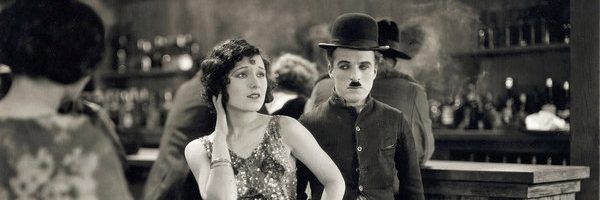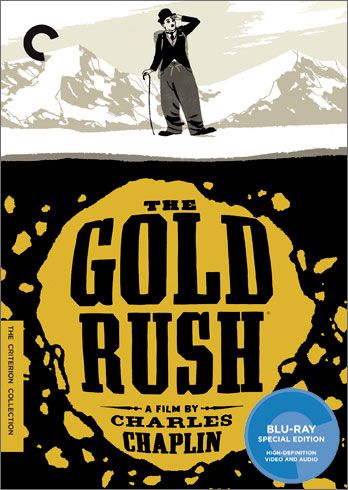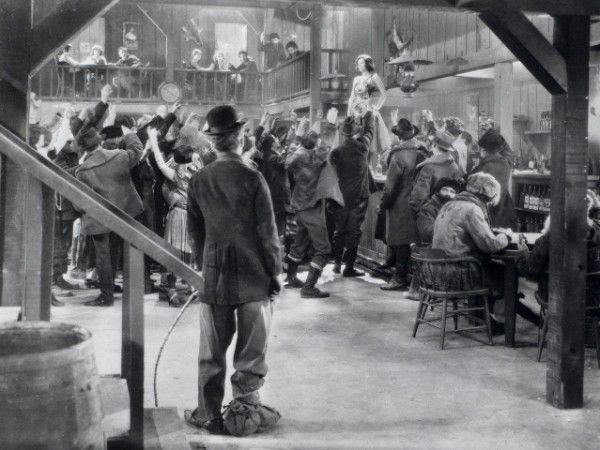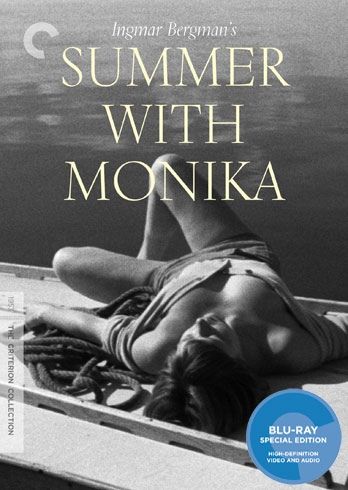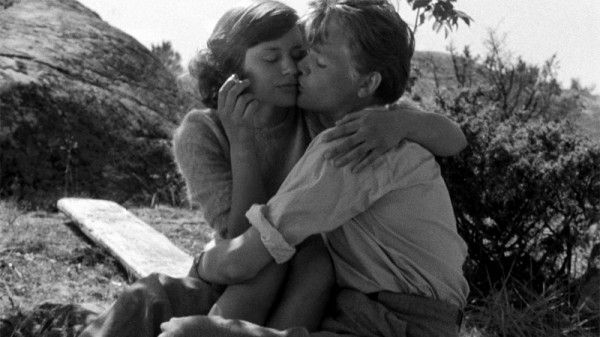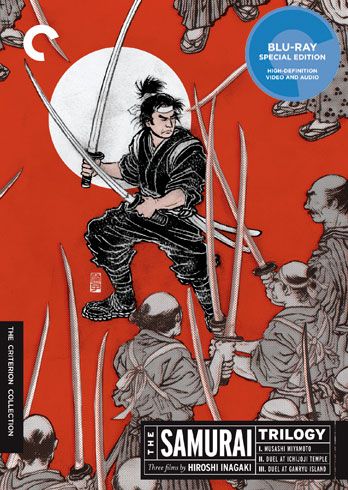One expects nothing less than masterpieces from the Criterion Collection, as they are home to some of the great masters of cinema. Recently they’ve put out Charlie Chaplin’s The Gold Rush, Ingmar Bergman’s Summer with Monika, and Hiroshi Inagaki’s Samurai Trilogy. And we’ve got reviews of all three on Blu-ray after the jump.
Though iconographically, Charlie Chaplin’s little tramp is still known worldwide, his films – which were box office blockbusters – are now left to classrooms and history. It’s such a strange fate for the populist performer, but even Shakespeare – who writes of sex and murder – can become boring to a new generation that is told something is a classic and important and silent films are always going to be a high hurdle. Even by 1942, Chaplin knew that a silent film had little relevance, so he took The Gold Rush (one of his most successful movies), recorded an audio track narration for the film and cut it from about 88 minutes to 72 minutes for a successful re-release.
The Gold Rush stars Chaplin as his tramp character – here called “The Lone Prospector” who goes to Alaska hoping to make his fortune. There he meets Big Jim McKay (Mack Swain), who has found his mountain of gold, and Black Larson (Tom Murray), who is wanted by the law. The three end up in a house together trying to survive the cold weather, and while there, Big Jim and the Tramp get so hungry they end up eating a shoe. Eventually Black Larson is killed, Big Jim loses his memory and the little tramp heads into town, where he finds work looking after someone’s home while they go prospecting. In town he falls for showgirl (and possible prostitute) Georgia (Georgia Hale), but doesn’t realize she’s dating someone else. When the two run into each other at his place, she and her friends say they’ll spend New Year’s Eve with him, knowing that the tramp has a crush on Georgia. He spends all his time earning money to make things nice for that night, but when it arrives, the ladies are a no show. Eventually Big Jim remembers everything and he and the tramp go to find his gold.
There are a number of famous set pieces here, from Chaplin using little bread loaves as feet to do a dinner dance, to the sequence where two men are so hungry they begin envisioning the other as food, to the wind sequences, where Chaplin does what mimes are famous for. Between this and Modern Times, you’ll find the majority of the classic Chaplin bits.
But what comes across strongest is that silent films - indeed the whole language of cinema back then - were geared toward creating empathy. Chaplin’s tramp is a real bona fide outsider. He’s not a cool outsider, he’s a member of the lower class just trying to get by, unaware of how lucky he can be, and a real romantic who can fall in love with a woman in one look. If one chooses to disengage from the film because its age, it’s possible to be unmoved and uninvolved, but Chaplin is a master manipulator and if you go along with the movie it’s impossible not to root for his character. And that was the secret to his success. It’s a lesson that has unfortunately been lost in an era of sarcasm and irony. But Chaplin’s heart (or at least the heart of the film) beats pure. And it’s amazing to watch. Comedy is about surprise, and Chaplin’s beats – while gentle compared to more modern iterations – still have a punch because he always knows to make a gag more than just what’s expected, and often things go off in odd and brilliant directions. This is probably the best Chaplin film to watch if you’ve never seen one before.
The Criterion Collection release contains the restoration of the 1925 silent version, which is thought to be the most complete version of the original release, and the 1942 reissue. Both look great for their age, though speckles and wear are unavoidable in this case. The film is presented in its original aspect ratio (1.33:1), with a mono mix for the ’42 version, and a 5.1 DTS-HD Master audio recording of the film’s score for the silent release. The silent version also comes with a great commentary by Timothy Brock, who walks through the main interest points about the making of the movie, and some of how Chaplin made the film, and his later cuts. “Presenting The Gold Rush” gets commentary from Jeffery Vance and Kevin Brownlow about how the film was reassembled (16 min.). It’s followed by ‘Chaplin Today: The Gold Rush’ (27 min.) which features interviews with Mary Pickford, co-star Georgia Hale, and African filmmaker Idrissa Ouedraogo on the movie. ‘A Time of Innovation’ gets effects maker Craig Barron to talk about the matte paintings and effects work in the film (19 min.). The score (which was written by Chaplin) gets its due in ‘Music by Chaplin’ (25 min.) and the set closes out with four trailers for the movie.
It’s hard to think of Ingmar Bergman making a sexy movie. The master is usually personified as having a Nordic coldness, and for his more esoteric works that question life and death. But his earlier (and arguably funnier) films all had a spring in their step, and though Summer with Monika deals with some tough issues, it’s about youth, sex about growing up.
The titular Monika is played by Harriet Andersson, and she’s a young adventurous girl who meets delivery boy Harry (Lars Ekborg), and the two fall into a quick romance. When she gets in trouble at home, he takes his father’s boat and quits his job so the two can spend a summer on the beach. That summer’s enough to get Monika pregnant, and so the two commit to marriage, but it’s much harder on Monika to accept the responsibilities of motherhood.
The film was cut to 63 minutes to play as an exploitation film in America, and like many foreign films of the 1950’s and 60’s, it features the casual sex and nudity that made many young men take their chances on a foreign film in the hopes of seeing… something. But that nudity is in the film for a good reason, and that’s because it shows much about Monika’s character. That she would walk around a beach naked and how she walks around whilst naked says a lot about her character.
The film is worth seeing, but it’s minor Bergman in the sense that his career features a number of great high points (Wild Strawberries, Smiles of a Summer Night, The Seventh Seal, Fanny and Alexander, and Scenes from a Marriage to name a handful). But this is also what would pass for a teen picture in America, and it shows the highs and lows of young love. It’s felt, and it’s obvious – as the supplements confirm – that Bergman was in love with Andersson at the time.
The Criterion edition presents the film in its original aspect ratio (1.33:1) and in 2.0 Mono. The presentation is exceptional, and the transfer is excellent - it seems that the Swedes have looked after their most famous filmmaker. The film comes with an introduction by director Ingmar Bergman (4 min.) which was done for television, and Bergman is affable in it. That’s followed by an interview with Harriet Andersson (25 min.) where she dishes on the making of the film, and proves very sharp about a film made sixty years old. There’s also an interview with film scholar Eric Schaefer about the exploitation cut of the film made for America (13 min.). ‘Images from the Playground’ features behind-the-scenes footage shot by Bergman and comes with archival audio interviews with Bergman and actresses Bibi Andersson and Andersson (30 min.) The disc concludes with the film’s trailer.
Hiroshi Inagaki’s The Samurai Trilogy won the best foreign film Oscar for its first episode, Musashi Miyamoto, and it is the film series that made Inagaki’s reputation (though, admittedly, few of his films have made it overseas other than these three and 1962’s Chushingura). The three film series follows Toshirō Mifune as Takezo, who goes off to war in hopes of glory, but ends up on the losing side. When he returns home he’s a fugitive, and is only saved by being captured by a Buddhist priest, who trains him. There he becomes samurai Miyamoto Musashi. In the second film time has passed and Musashi has become a great samurai and is subjected to many fights. All the while Musashi has been struggling with a lost love from his village. By the third film he’s challenged once more by his greatest opponent Kojiro Sasaki (Koji Tsuruta), who agrees to meet a year later. The trilogy concludes with their final showdown.
Though the trilogy has some good Samurai duels and enough soap opera to keep things entertaining, ultimately the narrative is flat. Miyamoto is based on a Japanese legend, and it’s great that he’s played by Mifune (Japan’s most famous actor), so perhaps this is more engaging for an audience who knows the character, and can see Mifune’s take on events they know. As an outsider, there are some great duels, but everything feels done at a half measure, and the series never got its hooks into me, except when swords come out. That’s when it got good, but the fights are few and far between. This may be the samurai version of a comic book movie, where it’s all surface, and all about seeing a character you love on screen.
The Criterion Collection presents the three films over two discs, with all films presented in the original aspect ratio (1.33:1) and in 2.0 Mono. The first two films are presented on disc one, with the first film coming with ‘On Mushami Miyamo, Part I’ (9 min.) with an interview of film historian William Scott Wilson, and the film’s trailer. The second film comes with ‘On Mushami Miyamo, Part II’ (7 min.) with Wilson, and the film’s trailer. On the second disc, the supplements consist of ‘On Mushami Miyamo, Part III’ (10 min.) and the film’s theatrical trailer.

